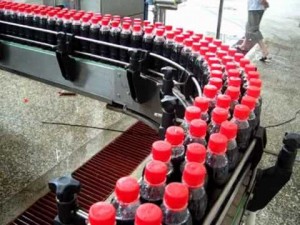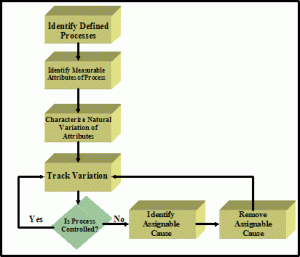While it’s true that upper and lower boundaries for SPC charts can be set by using some measure of central tendency and typical variation, there are sometimes other factors that will be used to determine process control limits. At Dremel, a power tool company owned by Bosch Power Tools, we heavily monitor and control our manufacturing processes. Dremel makes a line of light-duty power tools aimed at the DIY homeowner and craft/hobbyists markets. Many of their applications necessitate some degree of tool precision (of cut width, straightness, depth, smoothness, etc.) and so our processes are designed to achieve that end. Specifically, our manufacturing process controls for the presence of runout (misalignment between the tool axis and the cutting surface) and tests to look for excessive misalignment.
The interesting thing about our particular operation, though, is that the upper boundary for acceptable misalignment is not a function of the standard deviation of our process. Sure, it can be defined that way, but the number itself wasn’t selected using a statistical model. Rather, it was a marketing driven decision. Our product marketing group did extensive consumer insight research to determine what level of precision mattered for the types of projects our customers undertake. After determining that they were happy so long as the tools were at least some level of precise, the team reworked the manufacturing operation around achieving those numbers.
Of course Dremel uses some of the SPC tools we discussed in class to control its operations. For example, we track the number of defects and percent defective. It’s just that SPC isn’t the only framework in controlling our manufacturing process. Marketing, logistics, and other business functions also get involved and have a stake in making sure the products get made a certain way and according to a certain procedure. The manufacturing unit has to be responsive on all those fronts.
The point of bringing all of this up is two-fold. First, I wanted to highlight that in industry, while many of the operations management tools discussed in class are used, they are not applied in a vacuum and might be modified for a firm’s unique needs. Second, I wanted to encourage thinking about areas where business functions begin to overlap. Where disciplines begin to intermingle, we need to have some way of making decisions about which framework (or frameworks) ought to take precedent. We need to really understand the goal being pursued and select the most appropriate bits from marketing, finance, accounting, operations, etc., to maximize success.
Are there any instances from your experience where one discipline seemed to be calling the shots in another’s area of expertise? (Exs. Did marketing ever drive finance? Did operations ever affect accounting?)

